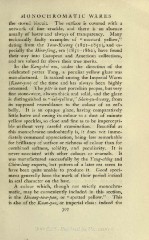Page 381 - Oriental Series Japan and China, Brinkly
P. 381
MONOCHROMATIC WARES
the stoved biscuit. The surface is covered with a
network of fine crackle, and there is an absence
usually of lustre and always of transparency. Many
technically faulty examples of " mustard yellow,"
dating from the Taou-Kwang (1821-1851), and es-
pecially the Hitn-fung, era (1851-1862), have found
their way into European and American collections,
and are valued far above their true merits.
In the Kang-hsl era, under the direction of the
celebrated potter Tang, a peculiar yellow glaze was
manufactured. It ranked among the Imperial Wares
(Kuan-yao} of the time and has always been highly
esteemed. The pate is not porcelain proper, but very
fine stone-ware, always thick and solid, and the glaze
is distinguished as " eel-yellow," Shan-yu-hwang, from
its supposed resemblance to the colour of an eel's
belly. It is an opaque glaze, having comparatively
little lustre and owing its colour to a dust of minute
yellow speckles, so close and fine as to be impercepti-
ble without very careful examination. Beautiful as
this monochrome undoubtedly is, it does not imme-
diately command appreciation, being less remarkable
for brilliancy of surface or richness of colour than for
combined softness, solidity, and peculiarity. It is
never associated with other colours or enamels. It
was manufactured successfully by the Tung-ching and
Chien-lung experts, but potters of a later era seem to
have been quite unable to produce it. Good speci-
mens generally have the mark of their period incised
in seal character on the base.
A colour which, though not strictly monochro-
matic, may be conveniently included in this section,
"
is the Hwang-tien-pan, or yellow." This
spotted
is also of the Kuan-yao, or imperial class : indeed the
37

